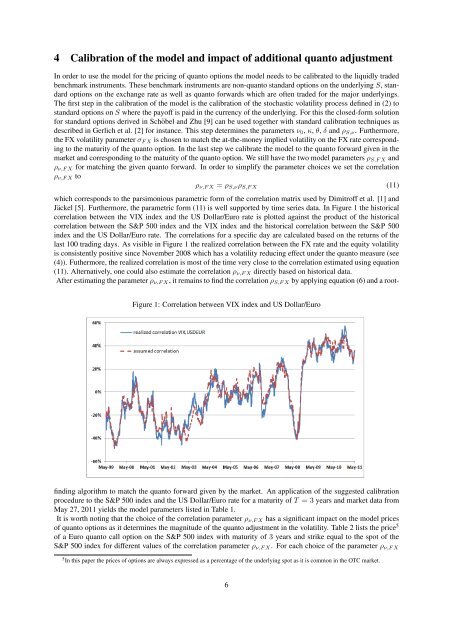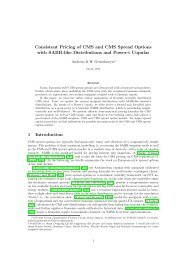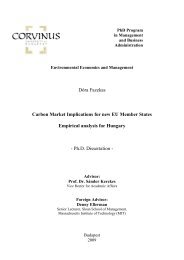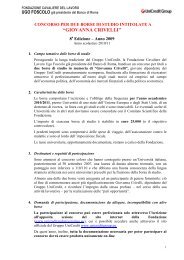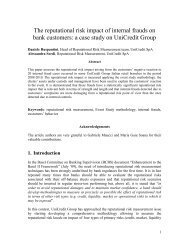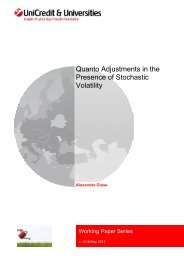Quanto Adjustments in the Presence of Stochastic Volatility
Quanto Adjustments in the Presence of Stochastic Volatility
Quanto Adjustments in the Presence of Stochastic Volatility
Create successful ePaper yourself
Turn your PDF publications into a flip-book with our unique Google optimized e-Paper software.
4 Calibration <strong>of</strong> <strong>the</strong> model and impact <strong>of</strong> additional quanto adjustment<br />
In order to use <strong>the</strong> model for <strong>the</strong> pric<strong>in</strong>g <strong>of</strong> quanto options <strong>the</strong> model needs to be calibrated to <strong>the</strong> liquidly traded<br />
benchmark <strong>in</strong>struments. These benchmark <strong>in</strong>struments are non-quanto standard options on <strong>the</strong> underly<strong>in</strong>g S, standard<br />
options on <strong>the</strong> exchange rate as well as quanto forwards which are <strong>of</strong>ten traded for <strong>the</strong> major underly<strong>in</strong>gs.<br />
The first step <strong>in</strong> <strong>the</strong> calibration <strong>of</strong> <strong>the</strong> model is <strong>the</strong> calibration <strong>of</strong> <strong>the</strong> stochastic volatility process def<strong>in</strong>ed <strong>in</strong> (2) to<br />
standard options on S where <strong>the</strong> pay<strong>of</strong>f is paid <strong>in</strong> <strong>the</strong> currency <strong>of</strong> <strong>the</strong> underly<strong>in</strong>g. For this <strong>the</strong> closed-form solution<br />
for standard options derived <strong>in</strong> Schöbel and Zhu [9] can be used toge<strong>the</strong>r with standard calibration techniques as<br />
described <strong>in</strong> Gerlich et al. [2] for <strong>in</strong>stance. This step determ<strong>in</strong>es <strong>the</strong> parameters ν0, κ, θ, δ and ρS,ν. Fur<strong>the</strong>rmore,<br />
<strong>the</strong> FX volatility parameter σF X is chosen to match <strong>the</strong> at-<strong>the</strong>-money implied volatility on <strong>the</strong> FX rate correspond<strong>in</strong>g<br />
to <strong>the</strong> maturity <strong>of</strong> <strong>the</strong> quanto option. In <strong>the</strong> last step we calibrate <strong>the</strong> model to <strong>the</strong> quanto forward given <strong>in</strong> <strong>the</strong><br />
market and correspond<strong>in</strong>g to <strong>the</strong> maturity <strong>of</strong> <strong>the</strong> quanto option. We still have <strong>the</strong> two model parameters ρS,F X and<br />
ρν,F X for match<strong>in</strong>g <strong>the</strong> given quanto forward. In order to simplify <strong>the</strong> parameter choices we set <strong>the</strong> correlation<br />
ρν,F X to<br />
ρν,F X = ρS,νρS,F X<br />
which corresponds to <strong>the</strong> parsimonious parametric form <strong>of</strong> <strong>the</strong> correlation matrix used by Dimitr<strong>of</strong>f et al. [1] and<br />
Jäckel [5]. Fur<strong>the</strong>rmore, <strong>the</strong> parametric form (11) is well supported by time series data. In Figure 1 <strong>the</strong> historical<br />
correlation between <strong>the</strong> VIX <strong>in</strong>dex and <strong>the</strong> US Dollar/Euro rate is plotted aga<strong>in</strong>st <strong>the</strong> product <strong>of</strong> <strong>the</strong> historical<br />
correlation between <strong>the</strong> S&P 500 <strong>in</strong>dex and <strong>the</strong> VIX <strong>in</strong>dex and <strong>the</strong> historical correlation between <strong>the</strong> S&P 500<br />
<strong>in</strong>dex and <strong>the</strong> US Dollar/Euro rate. The correlations for a specific day are calculated based on <strong>the</strong> returns <strong>of</strong> <strong>the</strong><br />
last 100 trad<strong>in</strong>g days. As visible <strong>in</strong> Figure 1 <strong>the</strong> realized correlation between <strong>the</strong> FX rate and <strong>the</strong> equity volatility<br />
is consistently positive s<strong>in</strong>ce November 2008 which has a volatility reduc<strong>in</strong>g effect under <strong>the</strong> quanto measure (see<br />
(4)). Fu<strong>the</strong>rmore, <strong>the</strong> realized correlation is most <strong>of</strong> <strong>the</strong> time very close to <strong>the</strong> correlation estimated us<strong>in</strong>g equation<br />
(11). Alternatively, one could also estimate <strong>the</strong> correlation ρν,F X directly based on historical data.<br />
After estimat<strong>in</strong>g <strong>the</strong> parameter ρν,F X, it rema<strong>in</strong>s to f<strong>in</strong>d <strong>the</strong> correlation ρS,F X by apply<strong>in</strong>g equation (6) and a root-<br />
Figure 1: Correlation between VIX <strong>in</strong>dex and US Dollar/Euro<br />
f<strong>in</strong>d<strong>in</strong>g algorithm to match <strong>the</strong> quanto forward given by <strong>the</strong> market. An application <strong>of</strong> <strong>the</strong> suggested calibration<br />
procedure to <strong>the</strong> S&P 500 <strong>in</strong>dex and <strong>the</strong> US Dollar/Euro rate for a maturity <strong>of</strong> T = 3 years and market data from<br />
May 27, 2011 yields <strong>the</strong> model parameters listed <strong>in</strong> Table 1.<br />
It is worth not<strong>in</strong>g that <strong>the</strong> choice <strong>of</strong> <strong>the</strong> correlation parameter ρν,F X has a significant impact on <strong>the</strong> model prices<br />
<strong>of</strong> quanto options as it determ<strong>in</strong>es <strong>the</strong> magnitude <strong>of</strong> <strong>the</strong> quanto adjustment <strong>in</strong> <strong>the</strong> volatility. Table 2 lists <strong>the</strong> price 5<br />
<strong>of</strong> a Euro quanto call option on <strong>the</strong> S&P 500 <strong>in</strong>dex with maturity <strong>of</strong> 3 years and strike equal to <strong>the</strong> spot <strong>of</strong> <strong>the</strong><br />
S&P 500 <strong>in</strong>dex for different values <strong>of</strong> <strong>the</strong> correlation parameter ρν,F X. For each choice <strong>of</strong> <strong>the</strong> parameter ρν,F X<br />
5 In this paper <strong>the</strong> prices <strong>of</strong> options are always expressed as a percentage <strong>of</strong> <strong>the</strong> underly<strong>in</strong>g spot as it is common <strong>in</strong> <strong>the</strong> OTC market.<br />
6<br />
(11)


